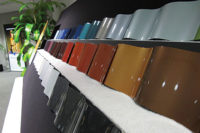
Car buyers who want to stay up-to-date when choosing the color of their cars in the next few years will opt for striking, mixed colors that defy the definition of classic colors. New trend-setting colors will no longer fit traditional descriptions like green, blue or gray, requiring, instead, names that reflect exotic combinations of colors and effects, such as "petrol-gray" or "greige" (a combination of gray and beige).
The full chromatic spectrum of such "hybrid" colors often reveals itself only under particular light conditions. Hints of turquoise may give blue a mysterious glow, while a delicate, pearly gloss may subtly infuse a pale green-gray. Viewers will be intrigued by surprising effects and color ambiguities that deliberately tease their perceptions. This approach to color was described by designers at BASF Coatings - Michaela Finkenzeller in Europe, Sandra Mathia in North America and Eiji Fujimori in Japan - at the presentation of the annual color trend forecast of BASF Coatings. Apart from colors and effects, the tactile quality of car surfaces is becoming increasingly important for car buyers. In the future, car surfaces will feature even greater differentiation than today - for example, high gloss, matte or a combination of both.
Car color forecasts are developed by BASF Coatings in close collaboration and consultation with designers in the global automobile industry. Experience shows that the new car colors being developed today will enter production within three to six years - that is, beginning in 2009 or 2010.
BASF's color experts study color trends in three major regions of the world: Europe, North America and the Asia/Pacific region. While all three regions have historically shared an affinity for some colors, they can differ widely in overall trends.
Trends in Europe
In Europe, silver will remain popular, but will continue to evolve. In small and subtle tonal steps, the new silver will move in more colorful directions. Warm, pearly variations of silver will blur the boundaries between silver and beige. The desire for changes in the standard color range opens the door to new interpretations that fall between silver and blue. Here, too, the new hybrid colors will make inroads.
In addition, silver will be complemented by other metal-like colors - such as copper, bronze, gold and platinum - that will give car bodies an entirely new metallic glow. A sense of class and elegance will now be conveyed by a wider range of colors, helping to fulfill customers' growing desire for individuality.
As a car increasingly becomes a comfort zone and place of refuge for "urban nomads," warm tones and calming colors that appeal to a desire for well-being and comfort, such as those in the beige to brown range, will become more popular.
Innovative effects will further enhance the brown, beige and "precious metal" colors of the future, creating novel color impressions, often requiring a second look to fully reveal the nuances of the car's finish.
Red will move to a much more prominent position among color favorites. Buyers will look for purity, depth and sporty effects in reds, but they will also be drawn to more fashionable tints in the coral range.
White, the ultimate expression of purist style and aesthetic straightforwardness, will become increasingly popular. Sophisticated and unambiguous, white is a color that helps clarify the language of the car's form. White with a pearly shimmer and special effects will remain a primary design objective, but uniform whites in new shades will further enrich this family of colors.
Although the interplay between color and special effects determined the design of the outer skins of automobiles over the past few decades, paint technologies of the future will offer a broader sensual experience than just a visual one. Matte and "soft touch" effects will provide a tactile experience and a completely new point of access to the automobile as an icon of technology, encouraging people to touch the car's finish. But for every trend, there is a counter-trend. In contrast to clear matte colors, there is a trend toward mirror effects and pure reflection.
The two extremes, however, do not exclude each other, but open up new possibilities for combining materials, colors and surfaces in the automobile's interior as well as on its exterior. Bright, discreetly tinted intermediate tones of silver will be most popular in this application, and perfectly matched two-colored surfaces will underscore the play of contrasts.
Trends in North America
Emerging trends in automotive colors in North America reflect people's need to relieve stress and their yearning for optimism and self expression.
Silver, long a dominant color in North America, is still perceived as a "value" color that evokes a sense of high technology, but it will continue to "reinvent" itself with hints of color, according to Sandra Mathia.
"We expect silver to remain popular because it conveys elegance, technology and power, combined with a sense of stability," said Mathia. "However, silver will continue to evolve in a trend that began a couple of years ago, picking up subtle colors or moving toward deeper, less mechanical tones."
Saturated pastels that offer a gentle lushness filled with color are predicted to be the new mid-tone colors in the foreseeable future. Green, a mixture of yellow and blue primary colors, will become a staple in the industry, continuing to reinvent itself in new shades and variations, a trend that is already seen in couture, home interiors and in muted to brightly colored cars. Orange is shifting toward copper tones, while deep browns, seen in dark, rich wooden floors and furnishings, will continue to reflect the strong influence of colors associated with nature.
Fresh-water blue and blue-greens approaching turquoise will keep growing in popularity for sporty applications, while luxury blues will trend toward the dark-red side. High-end and luxury vehicles will be enhanced with the introduction of dark, rich blood-reds, while fire red will remain highly popular for sporty cars.
Tinted blacks and shades of white, with glitter effects and so-called color travel, represent the opposite extreme from such solid classics as uniform white and black. We can expect silver, with its evocation of high technology, to remain a popular choice. Standard silver tones will be reinvented, however, with the addition of fluid tints and colors, lending a new and more colorful aura to traditional silver.
Trends in the Asia/Pacific Region
Four trends are currently influencing color tones in Asia and the Pacific region. The first trend is colors associated with a lifestyle of health and sustainability - colors such as green, brown and blue, which are associated with forests, the sky, water, environmental awareness and the health boom.
The second trend is classy and gorgeous colors associated with maturity. These are moderate, nuanced and muted colors such as champagne gold and dark, rich colors. A slight golden highlight is often effective in evoking a sense of class.
The third trend is expressed by futuristic colors such as white and silver, and by neutral colors such as black. The fourth trend is a focus on colors that emphasize textures, such as liquid metallics or mattes, a new category that promises to become more important.
These four trends will influence new variations on many traditional colors.
These hues bring environmental awareness to mind and evoke a feeling of calm and fulfillment. Designers will rely on variations of green, such as the color of green tea, and will experiment with a wide color range, from yellowish green to blue-green.
Do Automotive Color Trends Match Other Markets?
Mathia pointed out that, while automotive color trends are often related to color trends in other market segments such as fashion, the relationships are not as direct and relevant as some consumers expect. "Color preferences depend on many factors, including the object's purpose, its surface and texture, its use and many other considerations," Mathia said.
"The colors of fabrics and leathers used in the interiors of cars, for example, are not the same as the car's exterior finish, but clearly they must complement the finish. On the other hand, the colors used for apparel, household appliances and countless other applications must meet entirely different consumer needs and specifications."
Another difference between developing colors for automobiles and other uses is the lead-time. "The car colors we're talking about today may not be seen on the road for two or more years, while wardrobe colors can change dramatically every spring or fall," said Mathia.
"No matter how we look at it, color will always be a major factor for car owners," said Mathia. "At BASF we draw on our extensive color expertise and our global perspective to help our OEM customers develop colors that inspire consumers and respond to their emotional needs."



Report Abusive Comment